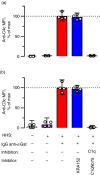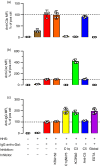Complement activation by human IgG antibodies to galactose-α-1,3-galactose
- PMID: 32583419
- PMCID: PMC7450175
- DOI: 10.1111/imm.13229
Complement activation by human IgG antibodies to galactose-α-1,3-galactose
Abstract
Some human antibodies may paradoxically inhibit complement activation on bacteria and enhance pathogen survival in humans. This property was also claimed for IgG antibodies reacting with terminal galactose-α-1,3-galactose (Galα3Gal; IgG anti-αGal), a naturally occurring and abundant antibody in human plasma that targets numerous different pathogens. To reinvestigate these effects, we used IgG anti-αGal affinity isolated from a pool of normal human IgG and human hypogammaglobulinaemia serum as a complement source. Flow cytometry was performed to examine antibody binding and complement deposition on pig erythrocytes, Escherichia coli O86 and Streptococcus pneumoniae serotype 9V. Specific nanobodies were used to block the effect of single complement factors and to delineate the complement pathways involved. IgG anti-αGal was capable of activating the classical complement pathway on all the tested target cells. The degree of activation was exponentially related to the density of bound antibody on E. coli O86 and pig erythrocytes, but more linearly on S. pneumoniae 9V. The alternative pathway of complement amplified complement deposition. Deposited C3 fragments covered the activating IgG anti-αGal, obstructing its detection and highlighting this as a likely general caveat in studies of antibody density and complement deposition. The inherent capacity for complement activation by the purified carbohydrate reactive IgG anti-αGal was similar to that of normal human IgG. We propose that the previously reported complement inhibition by IgG anti-αGal relates to suboptimal assay configurations, in contrast to the complement activating property of the antibodies demonstrated in this paper.
Keywords: alpha-galactosyl epitope; antibodies; antigens/peptides/epitopes; complement; human.
© 2020 John Wiley & Sons Ltd.
Conflict of interest statement
The authors declare no competing interests.
Figures







Similar articles
-
Abundant human anti-Galα3Gal antibodies display broad pathogen reactivity.Sci Rep. 2020 Mar 12;10(1):4611. doi: 10.1038/s41598-020-61632-9. Sci Rep. 2020. PMID: 32165720 Free PMC article.
-
The human natural anti-αGal antibody targets common pathogens by broad-spectrum polyreactivity.Immunology. 2021 Apr;162(4):434-451. doi: 10.1111/imm.13297. Epub 2021 Jan 4. Immunology. 2021. PMID: 33340093 Free PMC article.
-
Heterogeneity of human anti-pig natural antibodies cross-reactive with the Gal(alpha1,3)Galactose epitope.Transplantation. 1997 Aug 15;64(3):501-10. doi: 10.1097/00007890-199708150-00021. Transplantation. 1997. PMID: 9275119
-
An affinity for complement C3 as a possible reason for the potency of naturally occurring antibodies in mediating tissue homeostasis.Beitr Infusionsther. 1989;24:193-9. Beitr Infusionsther. 1989. PMID: 2481539 Review.
-
Gal alpha (1,3)Gal, the major xenoantigen(s) recognised in pigs by human natural antibodies.Immunol Rev. 1994 Oct;141:169-90. doi: 10.1111/j.1600-065x.1994.tb00877.x. Immunol Rev. 1994. PMID: 7532618 Review.
Cited by
-
Immune-Inflammatory Responses of an Acellular Cartilage Matrix Biomimetic Scaffold in a Xenotransplantation Goat Model for Cartilage Tissue Engineering.Front Bioeng Biotechnol. 2021 Jun 2;9:667161. doi: 10.3389/fbioe.2021.667161. eCollection 2021. Front Bioeng Biotechnol. 2021. PMID: 34150731 Free PMC article.
-
Alpha-Gal Bound Aptamer and Vancomycin Synergistically Reduce Staphylococcus aureus Infection In Vivo.Microorganisms. 2023 Jul 8;11(7):1776. doi: 10.3390/microorganisms11071776. Microorganisms. 2023. PMID: 37512948 Free PMC article.
-
Human IgG Subclasses Differ in the Structural Elements of Their N-Glycosylation.ACS Cent Sci. 2024 Oct 10;10(11):2048-2058. doi: 10.1021/acscentsci.4c01157. eCollection 2024 Nov 27. ACS Cent Sci. 2024. PMID: 39634222 Free PMC article.
-
Generation of αGal-enhanced bifunctional tumor vaccine.Acta Pharm Sin B. 2022 Jul;12(7):3177-3186. doi: 10.1016/j.apsb.2022.03.002. Epub 2022 Mar 9. Acta Pharm Sin B. 2022. PMID: 35865091 Free PMC article.
-
The importance of polyreactive antibodies in protection against pneumococcal infection.Immunology. 2021 Apr;162(4):339-340. doi: 10.1111/imm.13324. Immunology. 2021. PMID: 33729558 Free PMC article.
References
Publication types
MeSH terms
Substances
Grants and funding
LinkOut - more resources
Full Text Sources
Miscellaneous

